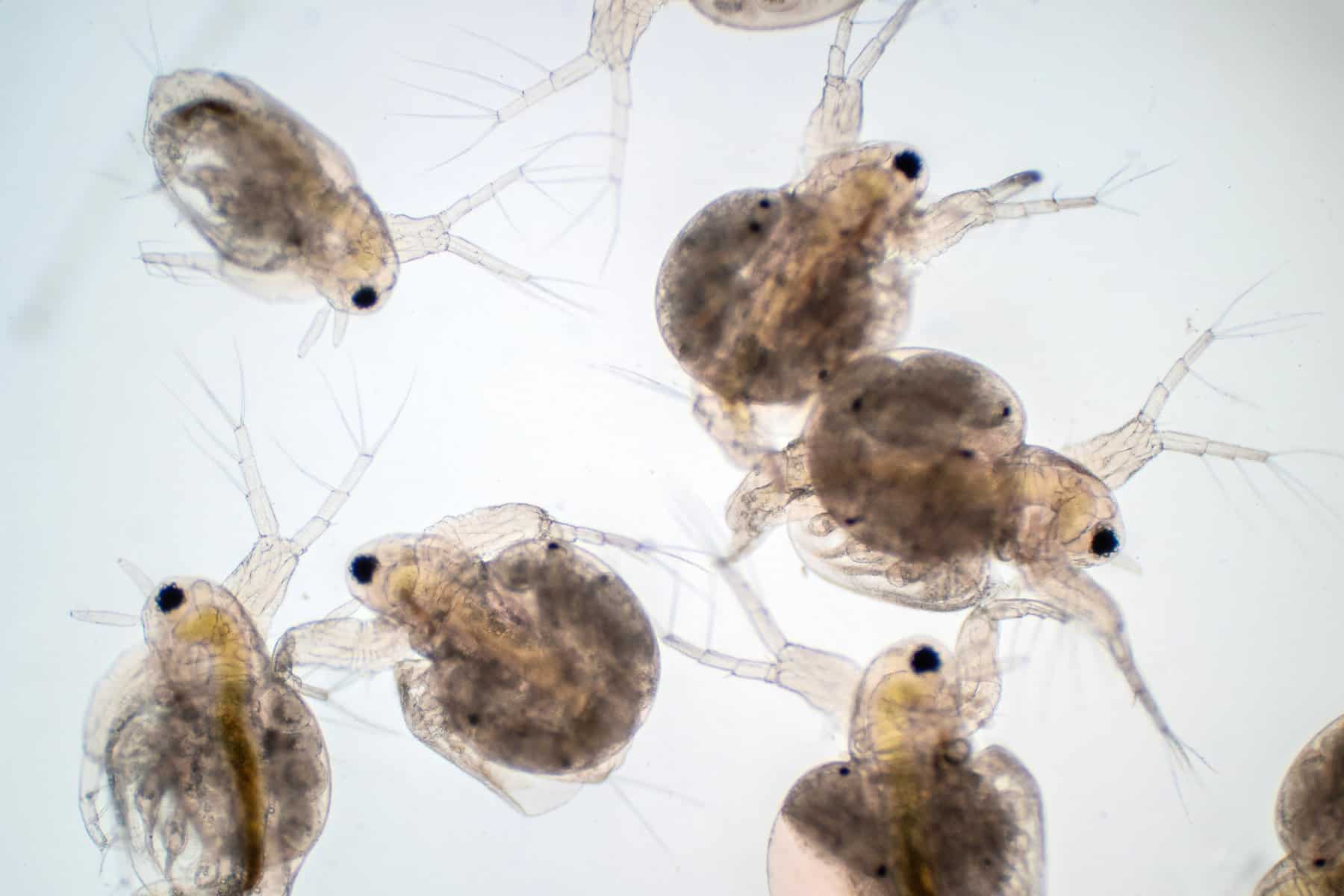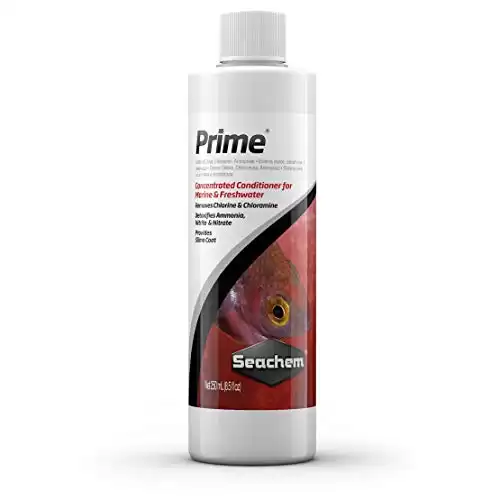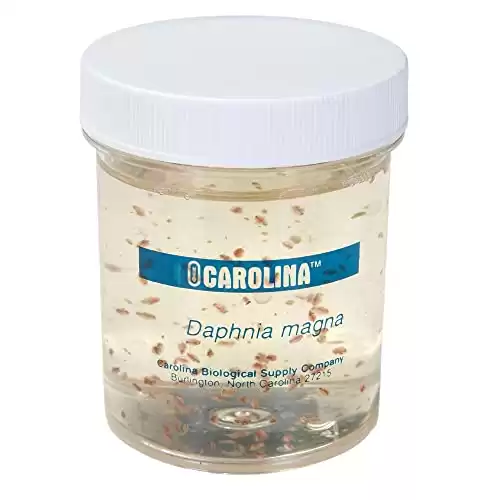Hear the name ‘water flea’ and you might start to feel itchy. But thankfully the type of animal we’re referring to here has nothing to do with the insects that can suck your blood!
Water fleas, or daphnia, are perfectly harmless in most aquarium settings and some fish keepers even use them as a source of food for their fish.
But what exactly are these mysterious critters, and what should you do if water flea populations get out of control? I’ll answer all your burning questions here.
What Are the Different Types of Water Fleas?
There are many types of tiny crustaceans that people refer to as ‘water fleas’. In reality, this common name could mean many different creatures, but in freshwater aquariums, the term usually refers to members of the Anomopoda order, namely daphnia.
The two most numerous water flea species are Daphnia pulex (up to 3mm long, and most common) and Daphnia magna (up to 5mm long, and popular as a live fish food!).
Although daphnia are sometimes referred to as ‘microscopic’, they are plenty big enough to see with the naked eye, although under a microscope they do reveal a beautiful and intricate translucent body.
Are Daphnia Really a Type of Flea?
No! The ‘water fleas’ known as daphnia have no relation and little resemblance to the wingless blood-sucking insects that make your dog or cat scratch!
In fact, daphnia are not parasites at all, and can actually be useful in an aquarium.
How Are Water Fleas Introduced Into an Aquarium?
Since water fleas are such common aquatic creatures, they can find their way into your aquarium by many means!
Sometimes they will attach themselves to plants or ornaments that are transferred from one fish tank to another.
Other times they will be lurking in aquarium gravel or even inside a filter that has been moved from a previous fish tank. Even one pregnant female water flea can start a whole new colony.
Daphnia also lay very robust eggs that can tolerate drying or even freezing! When these eggs return to a favorable environment like an aquarium, they hatch out, starting a new population.
Finally, some aquarists like to intentionally add live daphnia to their fish tanks for their fish to eat – in these instances, they are usually all consumed within a few hours.
How Are Water Fleas Useful in an Aquarium?
Daphnia are a normal part of healthy freshwater ecosystems and play a useful role in reducing the detritus and microorganisms suspended in the water.
This is because daphnia are filter feeders: they feed by wiggling their legs to create a current of water and draw particles into their digestive tract.
Common food items for daphnia include unicellular algae, protists, and bacteria. Yum!
In turn, daphnia are a popular food item for small fish such as minnows and tetras, and it can be great fun watching your fish race around hoovering up these nippy critters.
Can Water Fleas Be Harmful in an Aquarium?
Although water fleas are not normally considered a pest in aquariums, they can multiply quickly. If there are no fish to eat them, their numbers could get out of control.
This is especially likely in poor water quality where there is a lot of bacteria and algae for the daphnia to eat.
A daphnia bloom is not the worst thing to happen in your aquarium, but you might find them unsightly.
Also, if they exhaust their food supplies, the large numbers of dead water fleas could make water quality worse by causing ammonia levels to spike in your tank and thereby creating a toxic environment for fish and invertebrates.
The good news is that a daphnia bloom is very unlikely in a well-maintained aquarium and is fairly easy to rectify too.
How Do Water Fleas Become a Problem in Shrimp Tanks?
Large populations of water fleas are sometimes associated with shrimp tanks, because, unlike fish, shrimps are not very good at hunting them!
While pet shrimp species such as Amano shrimp, ghost shrimp, and cherry shrimp may nibble on any daphnia that come their way, they don’t have the speed and agility of small fish to decimate their populations.
Water fleas could also become a problem in a tank that only hosts very large fish such as Oscars or dragonfish. Large fish may simply find daphnia too small to be worth hunting, and so allow their populations to get out of hand.

How To Reduce Water Flea Populations in Your Aquarium
Let Your Fish Eat Them!
Where it’s possible, an easy solution to reduce daphnia populations in your fish tank is to introduce small fish that will eat them.
Small to medium-sized fish such as tetras, barbs, goldfish, and betta fish will relish the chance to chase down and gobble up daphnia.
Of course, if you’re keeping large fish it may not be safe to introduce smaller fish, so this is not a solution in every situation.
Make Some Partial Water Changes
Daphnia need detritus in the water to survive and thrive in poor-quality conditions.
Improve your tank’s water quality by performing a large 40% water change, replacing old tank water with fresh, treated tap water of matching temperature with your aquarium.
Changing 10-30% of your aquarium’s water every 1-2 weeks is an essential part of routine aquarium maintenance and will help to control daphnia populations.
Get a Better Aquarium Filter
Another aspect of keeping your tank clean and water quality high is an effective filtration system.
While some fish tank owners have tried to keep shrimp without a filter, it’s not recommended and your shrimp are unlikely to live for long.
A high-quality sponge filter or hang-on-back filter with carbon filtration will remove most of the debris from your water column, leaving behind less food for your daphnia to eat.
Use The Zucchini Trick!
Believe it or not, daphnia are crazy about eating blanched zucchini!
A tried and tested method of removing large numbers of them from the water is simply to blanch a large slice of zucchini in boiling water and place it in your fish tank.
Overnight, the daphnia will swarm onto the zucchini, meaning all you have to do is remove it and discard it in the morning to remove a large number of daphnia all at once.
How about that for a simple trick?
Use A Biological Tank Cleaner (not recommended)
As a last resort, some aquarists have used biological cleaners to kill daphnia. I’m not a big fan of this method, since with enough perseverance the above methods should prove effective and avoid the need to use toxic chemicals.
While biological cleaners aren’t supposed to harm your fish, they could be fatal to other crustaceans in your tank such as shrimps, crabs, or crayfish.
A large number of dying daphnia and other small organisms could also lead to a bacterial or algae bloom or even an ammonia spike, creating a much worse problem than you had to begin with!
How To Prevent Daphnia From Entering Your Aquarium
As I’ve pointed out, daphnia are not considered a pest in most aquariums, and many fish keepers actively introduce them to their aquariums as live food.
But if you’re concerned that daphnia could become a problem for your type of aquarium, there are a couple of preventative measures you could take to stop them from entering your fish tank in the first place.
Quarantine Your Plants and Decor
Hopping a ride on live plants and decor is one of the daphnias’ favorite ways of entering a new aquarium.
One way to reduce the risk of this is to place your plants, décor, or substrate in a specially designated quarantine tank to observe whether daphnia are present there.
Some aquarists routinely quarantine new plants for 2-3 weeks as a preventative measure against several potential pests and parasites such as anchor worms and snails.
If you see any small organisms hatching out or occupying your quarantine tank, you can then identify them and choose whether or not you want to introduce the plants to your main tank.
Bleach Dip Your Plants and Decor
Another method of reducing the risk of microorganism contamination on plants is by briefly dipping them in a bleach solution.
To do this, don a pair of rubber gloves and make a 1:20 solution of bleach and water to dip your plants in. In a second bowl, make a solution with a dechlorinating agent such as Seachem Prime to rinse your plants after the bleach dip.
- POWERFUL TREATMENT: Seachem Prime is a complete and concentrated conditioner for both freshwater and saltwater fish tanks, working hard to remove chlorine and chloramine.
- REMOVER: Seachem Prime immediately and permanently removes chlorine and chloramine, successfully allowing the bio filter to remove ammonia, nitrite, and nitrate while they are detoxified for 48 hours.
Before dipping, carefully rinse your plants and observe them closely for any signs of aquatic life such as daphnia, snails, or parasites and remove them by hand.
Completely submerge your plants in the bleach solution for 90 seconds (longer dips could kill your plants!) before thoroughly rinsing them under tap water and placing them in your dechlorinating solution to neutralize the chlorine.
Plastic plants and aquarium décor can be dipped for up to one hour in a similar solution without risk of damage.
FAQs
Can Daphnia Live in Marine Aquariums?
Daphnia are freshwater organisms that can only tolerate saline conditions up to ?3.98 PSU.
If you see what look like water fleas in a saltwater aquarium, they may be copepods – a type of small crustacean that lives in both fresh and saltwater but is more often associated with marine aquariums.
Copepods are similar to daphnia in their habits, feeding on detritus and algae, as well as feeding your fish. Likewise, many fishkeepers consider them a healthy and helpful component of the aquarium ecosystem.
What Is the Lifespan of Daphnia in an Aquarium?
In an aquarium full of small fish, daphnia are unlikely to live for more than half an hour! But with adequate sources of food and the absence of predators, each daphnia organism can live for just over one year.
Daphnia eggs, on the other hand, can lie dormant for a staggering 125 years and survive dry or freezing conditions while they wait for the right conditions to hatch out!
Is Daphnia a Good Food for My Pet Fish?
Live water fleas are one of the best foods for small fish, and indeed are an important part of the diet of many fish species in the wild. They contain a plentiful supply of protein, vitamins, and minerals for your fish.
Feeding daphnia to your fish also gives your fish important exercise as they race around the tank, hunting down the daphnia just as they would in the wild.
Watching this natural hunting instinct is fascinating, and your fish will often display their most vibrant colors and impressive appearance when in hunting mode!
Can Water Fleas Escape From My Aquarium?
Water fleas cannot survive outside of the water so there’s no risk of them exiting your fish tank. As mentioned earlier, they’re also not parasitic, so there’s no danger of them biting you or your pets!
The only way that water fleas could leave your aquarium is if your aquarium water is transferred to another aquarium, or by riding on plants, substrate, or décor as we discussed earlier.
How Can I Raise Feeder Daphnia To Feed My Fish?
Some aquarists like to raise cultures of daphnia as a constant live food source for their fish. Using the information in this article, you can probably figure out in which sort of environment daphnia grow best!
They need stable water conditions with plenty of algae and detritus in the water to feed on and will grow fastest at temperatures between 70°F – 80°F.
You can buy starter cultures of the larger Daphnia magna online here.
- A large species of Daphnia commonly used in aquatic effluent toxicity testing and physiology studies.
- An obligate algal feeder, D. magna can be successfully cultured using powdered Spirulina as a food source.
- Culture contains approximately 30 to 40 organisms - adults, juveniles, and neonates - per culture container.
Conclusion
Water fleas are a normal part of a healthy freshwater ecosystem and can make an excellent source of food for small to medium-sized aquarium fish.
If there are no predators, however, daphnia populations can get out of control.
I hope that the information here has helped you understand how to contain daphnia populations, and how to see the positive side of hosting this very under-appreciated aquatic organism!




